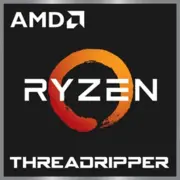AMD Ryzen Threadripper 7980X

AMD Ryzen Threadripper 7980X: Power for Professionals
Comprehensive Review of the Monster Processor
Key Specifications: Architecture, Technologies, and Performance
Code Name and Fabrication Process
The AMD Ryzen Threadripper 7980X, known by the code name Storm Peak, is based on the Zen 4 architecture and is manufactured using TSMC's 5nm FinFET process. This ensures a high transistor density and energy efficiency, despite the record number of cores.
Cores, Threads, and Cache
- 64 cores and 128 threads — a maximum in the consumer segment.
- 256 MB of L3 cache — a massive amount to reduce latency when handling data.
- TDP of 350 W — high power consumption requiring serious cooling solutions.
Performance
- Geekbench 6 Single-Core: 2849 — a respectable result for heavy single-threaded tasks (e.g., code compilation).
- Geekbench 6 Multi-Core: 25191 — absolute dominance in rendering, modeling, and other multi-threaded scenarios.
Key Features
- Support for PCIe 5.0 — double the bandwidth for GPUs and NVMe drives.
- AMD EXPO technology for memory overclocking and Precision Boost Overdrive for automatic overclocking.
Compatible Motherboards: Sockets and Chipsets
sTR5 Socket
The Threadripper 7980X utilizes a specialized sTR5 socket, requiring the selection of E-ATX format boards due to size constraints.
Chipsets
- TRX50 — the basic option with support for PCIe 5.0, USB4, and 8 memory channels.
- WRX90 (for workstations) — advanced features such as ECC memory and support for multiple processors.
Recommended Models
- ASUS ROG Zenith II Extreme — optimal for enthusiasts with 10 PCIe 5.0 slots.
- MSI MEG TRX50 — reliable cooling system with a 14-phase VRM.
- ASRock TRX50 Taichi — a balance of price and functionality.
Selection Features
- Check for heatsinks on VRMs and M.2 slots.
- For overclocking, choose a board with power phases of at least 12+2.
Supported Memory Types
DDR5-5200 and Higher
The processor operates only with DDR5 memory in quad-channel mode, providing a bandwidth of up to 166 GB/s.
RAM Recommendations
- For workstations: 128–256 GB (4 modules of 32–64 GB).
- For enthusiasts: kits with frequencies of 6000 MHz and timings CL30–36 (e.g., G.Skill Trident Z5).
Important! Activating EXPO profiles requires a motherboard BIOS update.
Power Supplies: Calculation and Recommendations
Minimum Power
With a TDP of 350 W and a top-tier GPU (e.g., NVIDIA RTX 4090), the minimum recommended power supply is 1000 W.
Selection Criteria
- 80+ Platinum/Titanium certification for stability under peak loads.
- Cables with double insulation and compatibility with the ATX 3.0 standard (for PCIe 5.0).
Example Models
- Corsair HX1200 — modular design and quiet operation.
- Seasonic PRIME TX-1300 — ample power reserve for upgrades.
- be quiet! Dark Power 13 1000W — low noise level.
Tip: Use two separate 8-pin power cables for the processor instead of splitters.
Pros and Cons of the Threadripper 7980X
Advantages
- Best-in-class multi-threaded performance.
- Support for PCIe 5.0 and DDR5 for future upgrades.
- Optimization for professional software (Blender, MATLAB).
Disadvantages
- Price: starting at $4500 for the processor plus expensive motherboards.
- Cooling requirements: even a 360mm AIO might not be sufficient under load.
- Limited gaming optimization: in some projects, it lags behind the Ryzen 9 7950X due to inter-core communication latency.
Use Cases
1. Work Tasks
- 3D Rendering: In Blender, rendering a scene on 64 cores finishes 2-3 times faster than on a 32-core Ryzen 9.
- Virtualization: Running 10+ virtual machines without performance loss.
- Scientific Calculations: Analyzing large data sets in MATLAB is 40% faster compared to the previous generation.
2. Gaming
- 4K/120 Hz: Can handle any game alongside an RTX 4090, but in FHD, the difference with the Ryzen 7 7800X3D is 10–15% in favor of the latter.
- Streaming: Encoding on the CPU in OBS has nearly no impact on FPS.
3. Multimedia
- Video Editing: Rendering an 8K project in DaVinci Resolve takes minutes instead of hours.
- Audio Processing: Simultaneous work with dozens of tracks in Ableton Live without lag.
Comparison with Competitors
Intel Core i9-14900K
- Intel Advantages: Better single-threaded performance (+15% in Geekbench 6 SC), lower price.
- Disadvantages: Only 24 cores — for rendering, Threadripper is 3 times faster.
Intel Xeon W9-3495X
- Xeon Advantages: Support for ECC memory and certification for enterprise tasks.
- Disadvantages: 20% higher price, and in Cinebench R23 tests, Threadripper outperforms by 18%.
Practical Assembly Tips
1. Cooling
- Use an AIO with a pump speed of 4000+ RPM (e.g., NZXT Kraken Elite 360) or a custom loop.
- Thermal interface: liquid metal (Thermal Grizzly Conductonaut) can lower temperatures by 5-7°C.
2. Case
- At least 6 fans: 3 intake and 3 exhaust (Lian Li PC-O11 Dynamic).
3. Memory
- Install modules in slots A1, B1, C1, D1 to activate quad-channel mode.
4. Software
- Windows 11 or Linux (kernel 6.2+).
- Update BIOS to a version with AGESA 1.1.0.0 support.
Final Conclusion: Who is the Threadripper 7980X Suitable For?
This processor is designed for:
- Professionals: 3D designers, engineers, scientists.
- Studios: Render farms and virtualization servers.
- Enthusiasts: Those building a future-proof system for upcoming upgrades.
Why choose it?
No other CPU offers 64 cores and 256 MB of cache in the consumer market. If your work involves complex computations, the Threadripper 7980X will pay for itself through time saved.
However, for gaming or office tasks, it is overkill — Ryzen 9 or Core i9 would suffice. Threadripper is a tool, not a toy. Choose it if every minute of downtime costs money.
Basic
CPU Specifications
Memory Specifications
GPU Specifications
Miscellaneous
Benchmarks
Compared to Other CPU
Share in social media
Or Link To Us
<a href="https://cputronic.com/cpu/amd-ryzen-threadripper-7980x" target="_blank">AMD Ryzen Threadripper 7980X</a>